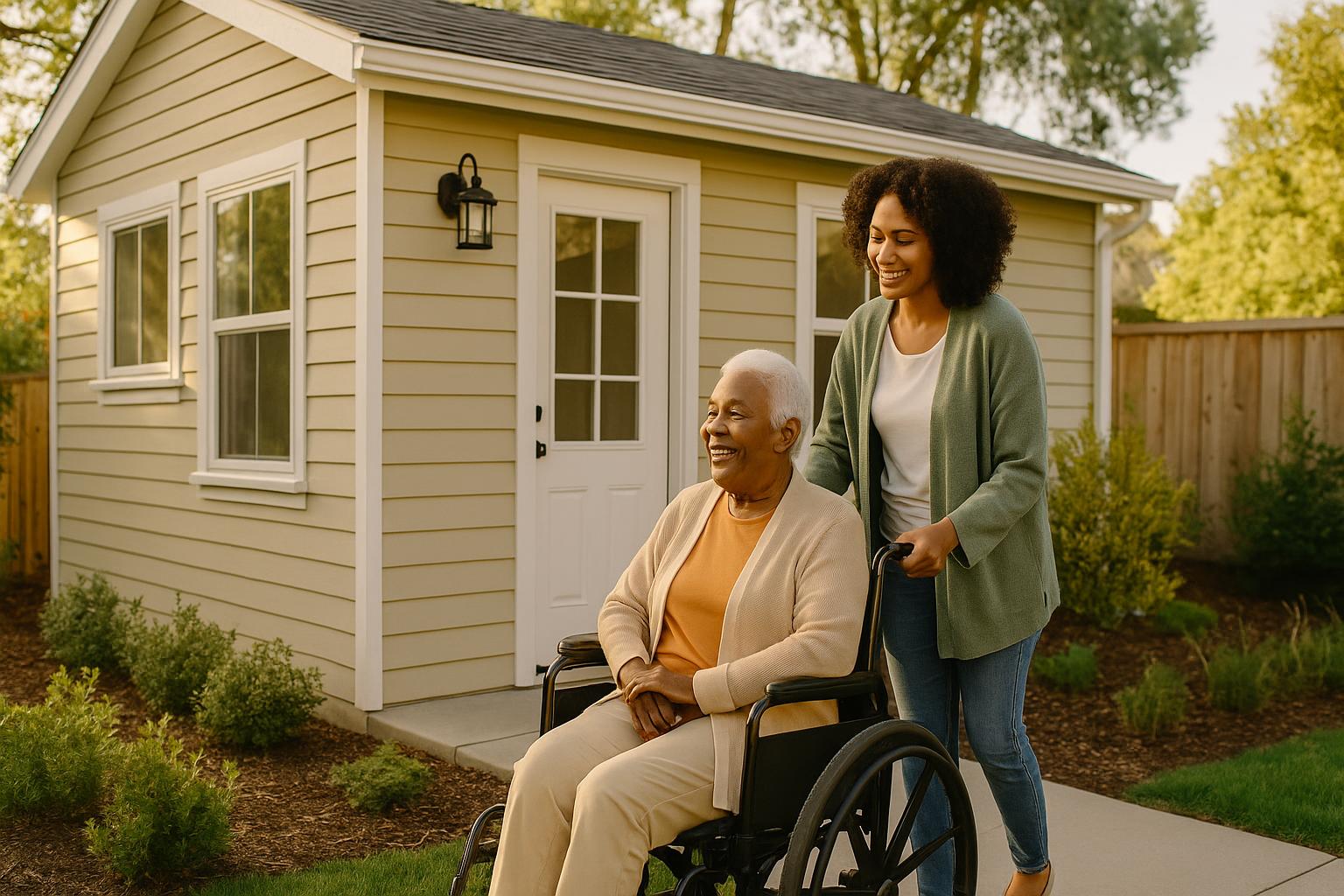
Estimated reading time: 8 minutes
How ADUs Enhance Caregiving Through Flexible Housing Solutions
Key Takeaways
- Flexible Housing: ADUs offer adaptable living spaces designed to evolve with family caregiving needs.
- Support for All Ages: They provide safe and private environments for elder care, new parents, and post-op recovery.
- Multi-Generational Living: ADUs facilitate family closeness while maintaining individual privacy.
- Thoughtful Design: Features like barrier-free access and adaptable layouts enhance ease of living.
- Regulatory Awareness: Understanding local codes and financial options is essential before building an ADU.
Table of Contents
- Introduction: Caregiving and the Rise of ADUs in Flexible Housing
- Understanding ADUs and Flexible Housing
- ADUs as Ideal Spaces for Caregiving
- Family Support Through ADUs
- Practical Considerations for Using ADUs in Caregiving
- Conclusion: ADUs—The Future of Flexible Housing for Caregiving
- Frequently Asked Questions
Caregiving is the essential support families provide for loved ones, such as aging parents, relatives with disabilities, and new parents. In this context, caregiving means offering physical help, emotional attention, or hands-on assistance to people who need it most. This crucial role helps families stay close and allows individuals to remain in familiar neighbourhoods instead of moving to care facilities. It keeps community bonds strong and helps reduce the strain on long-term care systems (source).
Accessory Dwelling Units (ADUs) are changing how Canadians view housing and caregiving. ADUs, also known as secondary suites, in-law suites, laneway houses, or backyard cottages, are innovative, self-contained homes constructed on the same lot as the main house. These flexible structures offer private and adaptable spaces that help families support each other across generations. Whether for a senior, a new parent, or someone recovering from surgery, ADUs provide the room and privacy needed for effective caregiving (source).
This blog post explains in detail how ADUs enable caregiving by expanding flexible housing options. We’ll explore how ADUs benefit elder care, support new parents, and create better environments for family recovery and support during health events.
Understanding ADUs and Flexible Housing
What Are ADUs? Types and Definitions
Accessory Dwelling Units (ADUs) are standalone living spaces distinct from the main home but located on the same property. Each ADU comes equipped with:
- A full kitchen
- Private bathroom
- Sleeping area
- Separate entrance for privacy and autonomy (source; source)
In Canada, the most common types of ADUs include:
- Basement Suites: Located below ground within the main house, with private access.
- Attached ADUs: Extensions or additions attached to the primary home, often with a shared wall but separate entrance.
- Detached ADUs: Separate buildings such as laneway houses, garden suites, or backyard cottages that stand alone on the property (source).
Flexible Housing: Adapting to Family Needs
Flexible housing means living spaces that adapt to changing family requirements. As households shift—when a parent ages or an adult child returns home—flexible housing lets families respond quickly.
ADUs embody this concept by providing:
- Space for senior relatives when caregiving becomes necessary
- Temporary housing during medical emergencies or surgeries
- An independent place for a young couple or new family to start out
Because ADUs can be customized and repurposed, they offer unmatched flexibility for caregiving. This adaptability is critical for Canadian families and helps future-proof housing arrangements (source).
Learn more:
https://presite.com/what-is-an-adu/
https://mardamanagement.com/blog/accessory-dwelling-units
https://www.adustart.ca/types-of-adus-canadian-guide/
https://www.centris.ca/en/blog/real-estate/what-do-you-know-about-accessory-dwelling-units
ADUs as Ideal Spaces for Caregiving
Caregiving for Elder Care in ADUs
ADUs are particularly helpful for elder care. Canadian seniors value both independence and proximity to family. An ADU strikes this balance by providing private, accessible, and secure living quarters. With the right design, ADUs support:
- Safe, barrier-free living: Features like no-step entries and wheelchair-width doorways make everyday activities safer for seniors.
- Privacy and dignity: An independent space respects autonomy, while being near loved ones supplies emotional comfort.
- Rapid response in emergencies: Family caregivers can check in often and react quickly if issues arise.
- Avoidance of institutional care: Many families prefer ADUs instead of long-term care facilities, promoting both health and family unity (source; source).
Seniors living in ADUs experience improved physical safety, less risk of social isolation, and benefit from familiar, supportive surroundings (source).
Related resource: For deeper insights on accessible and barrier-free living design that supports elder care, see our guide on Designing Accessible Tiny Homes and ADUs: A Comprehensive Guide to Barrier-Free Accessible Design.
Family Support for New Parents Using ADUs
For new parents, ADUs are a practical solution for building a strong support system. Families with infants or toddlers can benefit when grandparents or trusted relatives live nearby in a secondary suite:
- Immediate help is at hand: Assistance with childcare tasks is available without sharing the main home.
- Maintained privacy: Parents keep a quiet family environment while still tapping into family support.
- Flexible living: ADUs serve as long-term housing or transition spaces as children grow or family members’ needs change (source; source).
This results in a private, peaceful space for parents, while being just a few steps away from the extra help that relatives or grandparents can offer.
ADUs for Post-Op Recovery and Temporary Caregiving
Recovery from surgery or illness often requires a suitable environment—quiet, accessible, and close to help. ADUs can be tailored for convalescing family members, with features such as:
- Ground-level access: No stairs make movement safer and easier.
- Adaptable layouts: Temporary hospital beds or medical gear can be accommodated in open-plan suites.
- Tranquil, separate quarters: Patients benefit from peace and quiet while being near family for essential support (source; source).
Read further:
https://presite.com/what-is-an-adu/
http://novacon.ca/understanding-accessory-dwelling-units-adus-in-toronto/
https://www.centris.ca/en/blog/real-estate/what-do-you-know-about-accessory-dwelling-units
Family Support Through ADUs
Multi-Generational Living & Strong Support Systems
ADUs directly strengthen family support by allowing multi-generational living arrangements that protect both independence and togetherness. The impact on Canadian caregiving and elder care is significant:
- Physical proximity builds trust: Living close makes it easier to help with daily routines, chores, and healthcare needs.
- Privacy is preserved: Separate units mean families can share time together while still enjoying personal space.
- Reduced isolation: Having a loved one nearby cuts down loneliness and supports mental wellness.
- Practical logistics: Sharing responsibilities like meal prep and transport to appointments becomes much simpler.
Real-World Example: Toronto Family’s Laneway Suite
A Toronto family built an accessible laneway suite for an aging parent with features including ramps for easy entry, widened doorways for mobility aids, and accessible bathroom and kitchen layouts. This allowed the parent to remain active in family life while enjoying independence, with daily caregiving support readily available (source; source).
More info:
http://novacon.ca/understanding-accessory-dwelling-units-adus-in-toronto/
https://www.adustart.ca/types-of-adus-canadian-guide/
Practical Considerations for Using ADUs in Caregiving
Design Features for Effective Caregiving
To maximize caregiving in ADUs, good design is vital. Key features include:
- Accessibility:
- No-step entries to facilitate movement
- Wide doorways and halls for wheelchairs or walkers
- Lever-style door handles and accessible light switches
- Adaptable Spaces:
- Sufficient room for medical beds, walkers, or home care equipment
- Flexible layouts that can change as needs evolve
- Soundproofing: Helps reduce noise, ensuring privacy for recovery or rest.
- Proximity & Privacy: ADUs are close to the main home to allow easy help yet provide an independent space.
- Safety: Non-slip flooring, grab bars in bathrooms, and good lighting throughout the unit.
Ensuring these design elements are incorporated makes ADUs a flexible, long-term solution for caregiving (source; source).
See also: Our post on Designing Accessible Tiny Homes and ADUs offers detailed guidance on barrier-free and universal design features that improve caregiving environments.
Budget and Regulatory Considerations
ADU costs and regulations vary widely in Canada. Consider:
- Cost Factors:
- Basement and attached ADUs are generally more budget-friendly.
- Detached ADUs, such as laneway houses or backyard cottages, typically cost more due to independent utilities and additional construction requirements.
- Municipal Regulations:
- Cities regulate the number, size, and placement of ADUs with specific dimensions, parking needs, and setbacks.
- Recent updates in Ontario, British Columbia, and Quebec aim to support ADUs for family and caregiving uses (source; source).
- For more details, check out Canadian ADU Regulations: A Comprehensive Provincial Guide.
- Affordability Impact: Pro-ADU policies target affordable, flexible housing options for families caring for elders or those with disabilities.
Tips for Families Considering ADUs
- Plan for the future: Consider how spaces might change with evolving family needs, such as incorporating additional accessibility features over time.
- Talk to experts: Consult local city planners, building officials, or ADU specialists to stay updated on regulations and opportunities.
- Explore financial options: Look for grants or loans offered by municipalities, provinces, or organizations that support accessible housing enhancements (source).
For comprehensive financing insights, explore our guide: The Ultimate Guide to ADU Financing Canada.
Key research links:
http://novacon.ca/understanding-accessory-dwelling-units-adus-in-toronto/
https://www.adustart.ca/types-of-adus-canadian-guide/
https://mardamanagement.com/blog/accessory-dwelling-units
Conclusion: ADUs—The Future of Flexible Housing for Caregiving
Accessory Dwelling Units (ADUs) are a remarkably adaptable, flexible housing solution for Canadian families facing caregiving responsibilities. They allow loved ones to remain near each other, sharing daily life while preserving independence and privacy. ADUs help families care for seniors, support new parents, and provide safe spaces for recovery after surgery or illness (source; source; source).
By integrating thoughtful design, understanding local regulations, and building adaptability into every project, Canadian families can leverage ADUs to enhance caregiving and strengthen family support. The privacy and proximity offered by ADUs help every generation thrive.
Thinking about family caregiving? Now is the time to explore ADUs as a flexible, forward-thinking housing option. With new policies, innovative designs, and adaptable living spaces, ADUs are ready to meet the needs of today’s—and tomorrow’s—Canadian families.
Discover more:
https://www.centris.ca/en/blog/real-estate/what-do-you-know-about-accessory-dwelling-units
https://presite.com/what-is-an-adu/
http://novacon.ca/understanding-accessory-dwelling-units-adus-in-toronto/
Additional Recommended Internal Links for Related Topics:
– For insights on enhancing family support and multigenerational living with ADUs, see Multigenerational Living with ADUs: Innovative Family Housing, Privacy Solutions, and the Future of Canadian Homes.
– To understand how to create versatile ADU spaces, check ADUs: A Complete Guide to Benefits, Design, Financing, and Legal Tips for Homeowners and Investors.
– For guidance on accessible and inclusive ADU designs that benefit caregivers and seniors, see Accessible ADU Design: A Comprehensive Guide to Creating Safe, Inclusive Homes for Aging in Place in Canada.
– For planning a successful caregiving and flexible living space, review How to Create a Future-Proof ADU for Multi-Generational Living and Aging in Place.
– Learn more about improving privacy and comfort within ADUs in Soundproofing Tiny Homes: Essential Strategies for Privacy, Noise Reduction, and Comfort in Urban ADUs.
Frequently Asked Questions
What is an ADU?
An ADU (Accessory Dwelling Unit) is a self-contained living space constructed on the same lot as a primary home. It can serve as a private residence for family members or as an independent rental unit.
How do ADUs support caregiving?
ADUs provide flexible living arrangements that allow families to support aging parents, new parents, or individuals recovering from surgery, all while maintaining independence and privacy.
What are some key design features for care-oriented ADUs?
Important design features include barrier-free access, adaptable layouts, soundproofing, safety elements like non-slip floors and grab bars, and the right balance of proximity and privacy.
Are there financial or regulatory considerations?
Yes, ADU building costs and municipal regulations vary. It’s important to review local codes, explore financing options, and consult experts to ensure the project meets all guidelines and budget requirements.

Leave a Reply